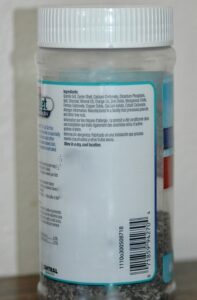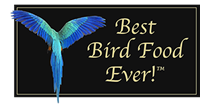Before reading this article, be sure you have read the ‘Never Feed Bird Grit’ post, it provides valuable information.
Be Aware of Ingredients
In reviewing the ingredient list on this label of bird grit, the ones below in CAPITALS are the ingredients that are toxic and harmful. It’s these ingredients you want to avoid. Of 14 ingredients, 11 are considered harmful. I hope you’re starting to rethink your strategy about feeding your parrots or finches bird grit.
The product label from the product I have reads: granite grit, oyster shell, CALCIUM CARBONATE, DICALCIUM PHOSPHATE, SALT, CHARCOAL, MINERAL OIL, orange oil, ZINC OXIDE, MANGANOUS OXIDE, FERROUS CARBONATE (IRON), COPPER OXIDE, CALCIUM IODATE (source of iodine), COBALT CARBONATE.
.

Click on image to enlarge.
Calcium Carbonate
Calcium carbonate is a supplement used to prevent or treat low blood calcium levels in individuals who do not get enough calcium from their diets. In birds calcium carbonate is used to supplement diets that lack many essential nutrients.
Did you know this commonly used supplement has serious side-effects? This is why I consider it a harmful ingredient in this bird grit.
These Common Side Effects of Calcium Carbonate include:
-
- Loss of appetite
- Constipation
- Nausea
- Vomiting
- Calcium Metabolism Imbalance, caused by High Calcium Levels
- Low Phosphate Levels (Calcium Metabolism Imbalance)
- Milk Alkali Syndrome, caused by excess calcium levels can lead to kidney failure and death.(5)
Dicalcium Phosphate
According to a research paper published in the, “Journal of Hazardous Materials” – yes, this says Hazardous Materials – the dicalcium phosphate commonly used in animal feed and supplements contains radioactive materials. This fact is appalling. I will be creating a unique article. Stay tuned for this upcoming blog post on this toxic ingredient in bird grit.(6)
.
Salt
In this product SALT is the fifth ingredient. Although sodium chloride is an essential nutrient, too much salt can throw off the body’s delicate electrolyte balance and can cause food addiction behaviors in birds. In people, ‘salt food addiction’ occurs when we crave salty chips and other salty junk foods. Eating too much salt causes water retention and this raises blood pressure. As things progress, this water retention leads to strain on the heart, arteries (arteriosclerosis), and kidneys. These stresses are the cause of heart attacks, strokes and kidney disease.(3) Salt consumed in excess amounts is a harmful ingredient in bird grit.
Charcoal
In an emergency, charcoal powder is used to absorb toxic substances and to prevent them from being absorbed by the body. In non-emergency situations ingesting charcoal can disrupt and prevent the absorption of essential vitamins, minerals and other nutrients. Because charcoal causes nutrient malabsorption it is a harmful ingredient in bird grit.
Mineral Oil
Commonly used in people for constipation, sides effects include pneumonia, lung disease and aspiration (suffocation). Longterm use causes deficiencies in the essential fat-soluble vitamins: A, D, E, and K. Because of this mineral oil causes nutritional imbalances. And this contributes to avian malnutrition. Mineral oil should not be used when the individual has a swallowing dysfunction.(7) Mineral oil in bird grit can actually
Zinc Oxide
This ingredient is an inorganic compound. This means it cannot be dissolved in water or in the avian digestive tract. Most zinc oxide is produced synthetically with its uses ranging from commercial use in rubber and plastics to cigarette filters.(1)
Manganous Oxide
This additive is suppose to supply the mineral manganese. However, You can avoid it completely because manganese is easily found in many foods. Because the manganese is in a food, instead of a rock, it is easier for the body to digest and use. Manganese is in almonds, pecans, walnuts, beans, legumes, oats, brown rice, green leafy vegetables and fruits such as raspberries. My favorite green leafy vegetable for birds is spinach. Please ignore the old wive’s tale to never feed birds spinach. Spinach is an essential avian food.
Manganous Oxide Dangers
The danger of manganous oxide used in bird grit is that if the dust is inhaled it can result in causing multiple neurological (nervous system) problems. When manganous oxide dust is inhaled it is transported directly to the brain. Because of this the liver does not have a chance to metabolized it and break it down. The symptoms of manganese toxicity generally appear slowly over a period of months to years.
In its worst form, manganese toxicity can result in:
-
- Permanent neurological disorder
- With symptoms similar to those of Parkinson’s disease,
- Including tremors,
- Difficulty walking,
- Facial muscle spasms.
Behavior symptoms include
-
- irritability
- Aggressiveness
When inhaled the lungs can become inflamed causing:
-
- A cough
- Acute bronchitis,
- And decreased lung function).(2)
Ferrous Carbonate (Iron)
This ingredient is listed in the US National Library of Medicine HSDB (Hazardous Substance Database): TOXNET (Toxicology Data Network). Now for me, this would be enough to never feed anything containing ferrous carbonate ever again.(8)
However, if you need more reasons to never feed this iron supplement to your birds keep reading. According to WebMed when using this supplement the subject must be closely monitored. Now, this is impossible to do when free-feeding bird grit.
Ferrous Carbonate (Iron) Side Effects
More on this toxic bird grit ingredient. Side effects for ferrous carbonate include:
-
- Stomach upset and pain,
- Constipation or diarrhea,
- Nausea and vomiting.
- Iron supplements can also cause blood hemoglobin disorders,
- Inflammatory bowel disease,
- Ulcerative colitis and
- Crohn disease (inflammatory bowel disease).(9)
Iron Poisoning – Most Common
According to WebMed, iron poisoning is the most common cause of poisoning in children. Because our parrots and finches are much smaller than human children your awareness can prevent problems from occurring.
These symptoms include:
-
- Stomach and intestinal distress,
- Liver failure,
- Dangerously low blood pressure
- And death.
If you suspect your bird has eaten too much grit – this is a life threatening condition. A trip to your closest Animal ER (Emergency Pet Hospital) may be necessary to save your bird’s life. Always call ahead to be sure they have a vet trained to treat birds.(9)
Iron has also causes problematic drug interactions with antibiotics, bi-phosphate, and other medications.(9)
Iron Storage Disease (ISD)
The cause of ISD is not understood. Because of this, avoid feeding foods to your birds that are high in iron. Additionally, avoid feeding supplements that contain iron.
Copper Oxide
The ‘Material Safety Data Sheet’ for Copper Oxide reads:
HARMFUL OR FATAL IF SWALLOWED.
Copper oxide side effects include:
-
- gastrointestinal irritation
- nausea,
- vomiting,
- diarrhea.
Effects of single exposure include:
-
- epigastric pain,
- headache,
- nausea,
- dizziness,
- vomiting
- diarrhea,
- tachycardia (irregular heart beat),
- respiratory difficulty,
- hemolytic anemia,
- hematuria,
- massive gastrointestinal bleeding,
- liver and kidney failure,
- and death.
Why is copper oxide even being used in a supplement for birds?
Calcium Iodate (source of iodine)
Possible side effects include nausea, stomach pain, runny nose, headache, metallic taste and diarrhea, worsening of dermatitis (skin rash). In sensitive people, iodine can cause swelling of the lips and face (angioedema), bleeding, bruising, fever, joint pain, lymph node enlargement, allergic reactions including hives, or death.(10)
Cobalt Carbonate
This ingredient is listed in TOXNET, the Toxicology Data Network, and is described as a known carcinogen.(11) TOXNET cites numerous references of how cobalt carbonate has caused cancer, lung fibroids, bronchitis and emphysema in both people and animals. However, the FDA has ignored this data and concludes that it is safe to use in animal feeds and supplements.(11) With respect, I completely disagree.
*********************
Look for my upcoming posts:
“Is Your Bird Grit Radioactive?”
“Healthy Bird Grit Alternatives”
**********************
Download this FREE Report
“Why Your Parrots Need Balanced Nutrition”
https://www.bestbirdfoodever.com/articles/
Take a look at this video:
‘Why Bird Seed is Bad for Your Bird’
Get Started Today!
Because I know you care about the health and welfare of your birds, here’s a coupon for 10% off your order of Best Bird Food Ever!
myhealthybird
(This coupon cannot be used with our 25# sizes, these are already priced at a discount.)
Thank you!
.
.
RESOURCES
(1) De Liedekerke, Marcel (2006) “2.3. Zinc Oxide (Zinc White): Pigments, Inorganic, 1” in Ullmann’s Encyclopedia of Industrial Chemistry. Wiley-VCH, Weinheim. doi:10.1002/14356007.a20_243.pub2 . Accessed Novemebr 7, 2019.
(2) Linus Pauling Institute, Micronutrient Information Center, ‘Manganese’, Oregon State University. https://lpi.oregonstate.edu/mic/minerals/manganese#food-sources . Accessed November 7, 2019.
(3) Blood Pressure UK, ‘Why Salt is Bad’, © Blood Pressure Association 2008. http://www.bloodpressureuk.org/microsites/salt/Home/Whysaltisbad . Accessed November 7, 2019.
(4) ‘Material Safety Data Sheet Material Name: Copper Oxide or Cupric Oxide’, ID: C1-118, http://highline.wa.safeschoolssds.com/document/repo/43e52dce-9808-11e3-9b6e-d8d230712f36 . Accessed November 7, 2019.
(5) ‘Calcium Carbonate’, Medical and Pharmacy Editor: John P. Cunha, DO, FACOEP. RxList, https://www.rxlist.com/consumer_calcium_carbonate_tums/drugs-condition.htm . Accessed November 8, 2019.
(6) Casacuberta N, Masqué P, Garcia-Orellana J, Bruach JM, Anguita M, Gasa J, Villa M, Hurtado S, Garcia-Tenorio R, ‘Radioactivity contents in dicalcium phosphate and the potential radiological risk to human populations’, Journal of Hazardous Materials, 2009 Oct 30;170(2-3):814-23. doi: 10.1016/j.jhazmat.2009.05.037. Epub 2009 May 15.
https://www.ncbi.nlm.nih.gov/pubmed/19515484 . Accessed November 8, 2019.
(7) Michael Weinstein MD, Department of Pediatrics, University of Toronto, The Hospital for Sick Children, Toronto, Ontario, ‘First do no harm: The dangers of mineral oil’, Paediatrics and Child Health, Vol 6 No 3 March 2001. The official journal of the Canadian Paediatric Society. https://www.ncbi.nlm.nih.gov/pmc/articles/PMC2804525/ . Accessed November 8, 2019.
(8) ‘Ferrous Carbonate’, TOXNET (Toxicology Data Network, National Library of Medicine HSDB (Hazardous Substances Database), https://toxnet.nlm.nih.gov/cgi-bin/sis/search/a?dbs+hsdb:@term+@DOCNO+458 . Accessed November 8, 2019.
(9) ‘Iron’, WebMed, Vitamins & Supplements, https://www.webmd.com/vitamins/ai/ingredientmono-912/iron . Accessed November 8, 2019.
(10) ‘Iodine’, Jan Modric, Nutrients Review(dot)com. http://www.nutrientsreview.com/minerals/iodine.html . Accessed November 8, 2019.
(11) ‘Cobaltous Carbonate’, TOXNET (Toxicology Data Network, National Library of Medicine HSDB (Hazardous Substances Database). https://toxnet.nlm.nih.gov/cgi-bin/sis/search/a?dbs+hsdb:@term+@DOCNO+999 . Accessed November 8, 2019.






